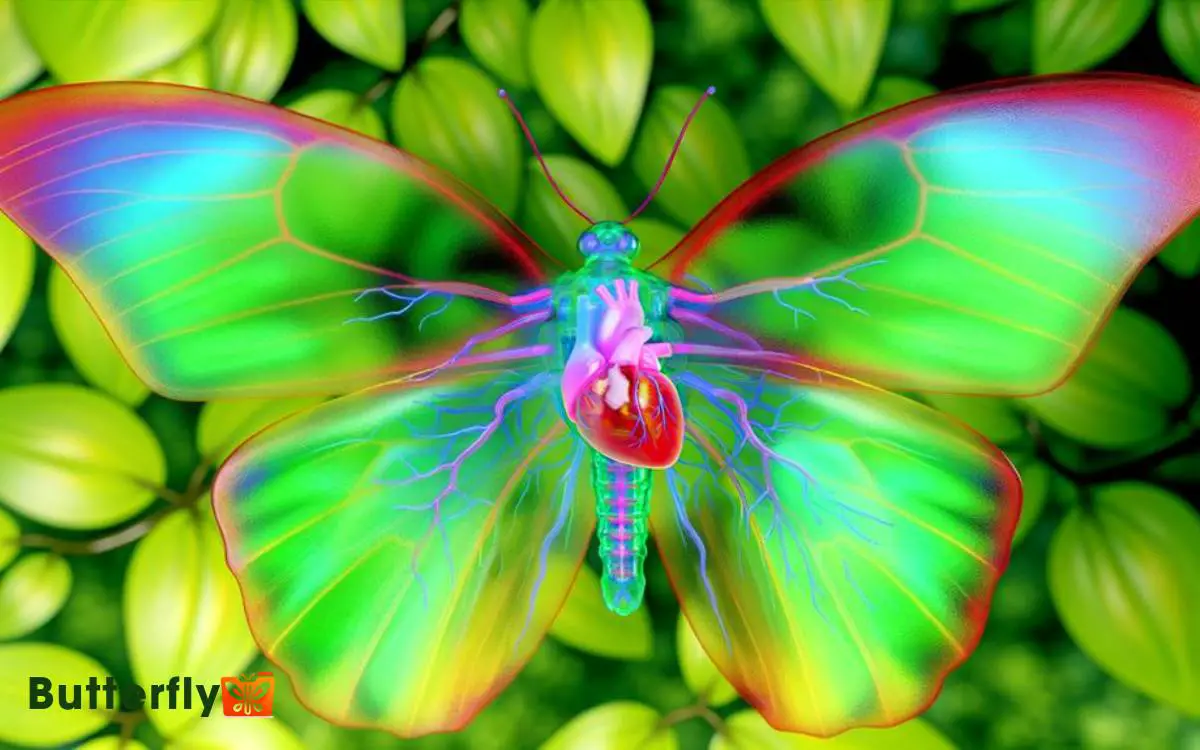Does a Butterfly Have a Heart? Yes!
Yes, a butterfly does have a heart. It’s a tubular organ running along the butterfly’s back, just beneath its exoskeleton.
This heart is part of an open circulatory system where hemolymph (insect blood) bathes the organs directly.
It pumps hemolymph through segmented chambers with valves to prevent backflow, ensuring efficient nutrient and waste transport.
Unlike humans, butterflies rely on a network of tracheae and spiracles for oxygen delivery rather than their circulatory system.
This setup is perfectly adequate for a butterfly’s metabolic needs. Curious about how these fascinating systems sustain a butterfly’s life functions?

Key Takeaways
Butterfly Anatomy Overview
To understand if a butterfly has a heart, you first need to grasp the basics of its anatomy. This includes the exoskeleton, wings, and internal organs. The exoskeleton acts as a protective outer layer made of chitin, providing structure and defense.
The wings, composed of membranes supported by veins, enable flight and are covered in scales that give butterflies their vibrant colors.
Internally, butterflies possess a digestive system, a nervous system with a brain and ventral nerve cord, and a respiratory system using spiracles and tracheae for gas exchange.
Additionally, there’s a muscular system that facilitates movement and a reproductive system essential for species propagation. Understanding these components is important before delving deeper into the specifics of their circulatory system.
Insect Circulatory Systems
Insect circulatory systems, unlike those of vertebrates, operate through an open system where hemolymph a fluid analogous to blood bathes internal organs directly rather than flowing through a network of blood vessels.
This system is less efficient for oxygen transport but sufficient for insects due to their smaller size and lower metabolic needs.
You’ll find that hemolymph serves several functions:
- Nutrient Transport: Delivers nutrients from the digestive system to cells.
- Waste Removal: Carries metabolic waste products to excretory organs.
- Thermoregulation: Helps regulate body temperature.
- Immune Response: Contains cells that combat pathogens and heal wounds.
Understanding this system reveals how insects maintain their physiological functions despite lacking a closed circulatory system like ours.
Open Vs. Closed Circulatory Systems
You need to understand that insects like butterflies have an open circulatory system where hemolymph flows freely within body cavities. This contrasts with closed circulatory systems found in vertebrates, where blood circulates within vessels.
Open systems are less efficient at oxygen transport, but they suffice for the metabolic needs of smaller organisms.
Hemolymph Flow Pathways
Butterflies possess an open circulatory system, where hemolymph flows freely through body cavities rather than being confined to blood vessels. This system allows hemolymph to bathe organs directly, facilitating nutrient and waste exchange.
Unlike a closed circulatory system, where blood circulates within vessels, the open system has:
- Hemolymph: The insect equivalent of blood.
- Dorsal vessel: A tube that acts like a heart, pumping hemolymph.
- Sinuses: Spaces where hemolymph collects around organs.
- Ostia: Valved openings in the dorsal vessel for hemolymph entry.
You’ll find that this flow pathway supports the butterfly’s metabolic needs effectively.
Efficiency in Oxygen Transport
When comparing open and closed circulatory systems, the importance of oxygen transport becomes a crucial factor impacting an organism’s metabolic demands and overall vitality.
In an open system, like that of a butterfly, hemolymph bathes organs directly, leading to slower and less targeted oxygen delivery. This system is less efficient, supporting lower metabolic rates.
Conversely, a closed system, seen in vertebrates, uses vessels to transport blood, allowing for rapid, precise oxygen distribution to tissues. This efficiency supports higher metabolic demands.
You might find that the open system suffices for insects due to their smaller size and lower oxygen needs, whereas larger, more active organisms benefit from the closed system’s superior oxygen transport capabilities.
The Butterfly Heart
When considering the butterfly heart, you’ll find its structure is quite different from that of vertebrates, featuring a tubular heart that runs along its dorsal side.
This organ plays a vital role in the butterfly’s open circulatory system, pumping hemolymph to transport nutrients and waste.
Adaptations such as this allow butterflies to thrive despite their small size and complex life cycles.
Structure and Function
Unlike the human heart, the butterfly’s heart is a simple tube-like structure that runs along its dorsal side, effectively pumping hemolymph throughout its body.
This heart, known as the dorsal vessel, consists of segmented chambers that contract rhythmically. Each segment has small valves called ostia, which allow hemolymph to enter the heart from the body cavity.
To understand this better, note the following:
- Dorsal Location: Positioned along the back.
- Segmented Chambers: Multiple compartments for efficient pumping.
- Ostia Valves: Tiny openings to regulate hemolymph flow.
- Hemolymph: Insect equivalent of blood, transports nutrients and waste.
These features enable the butterfly’s heart to maintain essential physiological functions, ensuring that its tissues receive necessary nutrients and oxygen.
Circulatory System Role
Although the butterfly’s heart is structurally simpler than a mammal’s, it plays a critical role in circulating hemolymph to transport essential nutrients, hormones, and metabolic waste throughout the insect’s body.
You’ll find that the butterfly heart is a tubular structure running along its dorsal side. This heart contracts rhythmically, propelling hemolymph forward into the aorta, which then distributes it into the open body cavity.
Unlike a closed circulatory system, hemolymph bathes internal organs directly. The heart’s function guarantees that oxygen, collected via the tracheal system, and crucial substances reach every part of the butterfly. Additionally, it helps remove metabolic waste products.
Understanding this system underscores the importance of the heart in maintaining the butterfly’s overall physiological balance.
Adaptations for Survival
The butterfly heart, with its rhythmic contractions and hemolymph propulsion, exhibits several essential adaptations that enhance the insect’s survival in diverse environments. You’ll find that these adaptations are vital for maintaining the butterfly’s homeostasis and overall functionality.
The open circulatory system allows for efficient nutrient and oxygen distribution despite the butterfly’s small size.
- Segmental Pulsations: Enhance hemolymph flow to different body parts.
- Dorsal Vessel Structure: Simplifies the movement of hemolymph from the abdomen to the head.
- Auxiliary Hearts: Aid in pumping hemolymph to the wings, essential for flight.
- Thermoregulation: Adjusts hemolymph flow to regulate body temperature in various climates.
Understanding these adaptations gives you a clearer picture of how butterflies thrive in their natural habitats.
Hemolymph: Insect Blood
Insects, including butterflies, have a circulatory fluid called hemolymph that functions similarly to blood in vertebrates. Hemolymph transports nutrients, hormones, and waste products throughout the insect’s body.
Unlike vertebrate blood, hemolymph is not confined to blood vessels but fills the body cavity, bathing internal organs directly. This open circulatory system allows for efficient distribution of substances despite the insect’s small size.
| Function | Hemolymph | Vertebrate Blood |
|---|---|---|
| Oxygen Transport | Limited | High (via hemoglobin) |
| Nutrient Distribution | Efficient | Efficient |
| Waste Removal | Effective | Effective |
| Circulatory System | Open | Closed |
| Presence of Cells | Hemocytes | Red/White Blood Cells |
You’ll notice that hemolymph plays a crucial role in maintaining the insect’s physiological balance, even though it doesn’t transport oxygen extensively.
Heart Structure in Butterflies
Butterflies possess a tubular heart that runs along the dorsal side of their body, pumping hemolymph to maintain essential physiological functions. This heart structure is quite different from the more familiar mammalian heart. Unlike mammals, butterflies rely on an open circulatory system, where hemolymph freely bathes the organs rather than being confined within blood vessels. This unique system supports their lightweight bodies and high-energy activities such as flying and feeding. Understanding these physiological differences is essential for those interested in keeping butterflies as pets, as their care requires specialized knowledge of their biological needs.
It’s a simple, elongated tube with multiple chambers and valves. The primary role of this heart is to guarantee the distribution of hemolymph throughout the butterfly’s body.
Key characteristics of a butterfly’s heart include:
- Tubular shape: Runs the length of the body.
- Multiple chambers: Each chamber helps propel hemolymph.
- Valves: Prevent backflow, ensuring one-way circulation.
- Dorsal location: Positioned along the back, just beneath the exoskeleton.
Understanding this unique heart structure helps illuminate the fascinating adaptations butterflies have evolved.
Circulation Process Explained
While analyzing the circulation process in butterflies, you’ll observe that their tubular heart contracts rhythmically to propel hemolymph through the body in a highly efficient manner.
The hemolymph, which serves a function similar to blood in vertebrates, is pushed from the posterior to the anterior end. This open circulatory system allows the hemolymph to bathe organs directly, facilitating nutrient and waste exchange.
The heart’s contractions create a flow that cycles hemolymph through the hemocoel, the primary body cavity. Each contraction guarantees that the hemolymph reaches all extremities, delivering essential nutrients and oxygen while removing metabolic wastes.
This continuous flow is essential for maintaining cellular functions and overall homeostasis, demonstrating an impressively streamlined process for such a small creature.
Role of the Dorsal Vessel
The dorsal vessel, a central component of a butterfly’s circulatory system, functions as both a heart and aorta, ensuring efficient hemolymph distribution throughout the body.
This elongated tube runs along the length of the butterfly’s body, pulsing rhythmically to move hemolymph from the posterior to the anterior. You’ll find it fascinating how this vessel coordinates circulation without a closed system.
Key functions of the dorsal vessel include:
- Pumping hemolymph: It actively moves fluids to nourish tissues.
- Regulating pressure: Maintains hemolymph pressure for effective nutrient and waste transport.
- Segmental division: Divided into chambers that aid directional flow.
- Resilience: Adaptable to different activity levels and environmental conditions.
Understanding the dorsal vessel’s role reveals how butterflies thrive with their open circulatory system.
Oxygen Transport Mechanisms
Have you ever wondered how butterflies manage oxygen transport without lungs or a closed circulatory system?
Butterflies use a network of tiny tubes called tracheae for oxygen delivery. Air enters through spiracles small openings on their exoskeleton.
From there, it travels directly to tissues via the tracheal system, bypassing the need for blood to carry oxygen. The tracheae branch into even finer tubes called tracheoles, which penetrate cells and facilitate gas exchange right where it’s needed.
This efficient system allows oxygen to diffuse directly into cells while carbon dioxide exits the same way. Consequently, butterflies can sustain their high-energy activities, like rapid flight, without the complexity of a mammalian respiratory system.
This mechanism is both simple and highly effective.
Nutrient Distribution
Beyond oxygen transport, butterflies also have a fascinating and efficient method for distributing nutrients throughout their bodies.
Hemolymph, their equivalent of blood, plays an essential role in this process. This fluid circulates in an open system, reaching all tissues and organs directly.
Nutrient distribution is facilitated by:
- Dorsal vessel: A tubular heart that pumps hemolymph from the abdomen to the head.
- Ostia: Inlet valves that allow hemolymph to enter the dorsal vessel.
- Peristaltic waves: Rhythmic contractions that propel hemolymph forward.
- Accessory pulsatile organs: Additional pumps aiding hemolymph flow to appendages.
These mechanisms ensure that nutrients, hormones, and waste products are efficiently transported, maintaining the butterfly’s metabolic balance. Understanding these systems reveals the intricate ways butterflies thrive in their environments.
Comparing to Human Hearts
You might be surprised to learn that a butterfly’s heart is a simple tube-like structure, while a human heart is a complex, four-chambered organ.
In butterflies, the heart pumps hemolymph through an open circulatory system, contrasting with the closed circulatory system of humans.
Understanding these differences highlights how each species has evolved its heart to meet its unique physiological needs.
Butterfly Heart Structure
Unlike the complex, multi-chambered human heart, a butterfly’s heart is a simple tubular structure that runs along its dorsal side.
This heart, also known as a dorsal vessel, is a single, elongated tube that pumps hemolymph, the insect equivalent of blood, through the butterfly’s body.
Key points to understand about butterfly heart structure:
- Single-chambered: The heart consists of a single chamber compared to the human heart’s four.
- Dorsal location: Positioned along the back, unlike the human heart’s central thoracic placement.
- Hemolymph circulation: Pumps hemolymph rather than blood, which bathes organs directly.
- Ostia: Small openings called ostia allow hemolymph to enter and exit the heart.
This simplistic yet efficient design supports a butterfly’s metabolic needs.
Human Heart Anatomy
The human heart, a sophisticated, multi-chambered organ, consists of four distinct chambers—two atria and two ventricles that work in concert to circulate oxygen-rich blood throughout the body.
You’ll find that these chambers are separated by valves to guarantee unidirectional blood flow. The right atrium receives deoxygenated blood from the body, while the right ventricle pumps it to the lungs for oxygenation.
The left atrium receives oxygenated blood from the lungs, and the left ventricle pumps it to the rest of the body. This intricate system is regulated by electrical impulses that maintain rhythmic contractions.
Unlike the simpler tubular heart of a butterfly, the human heart’s complexity allows for efficient, high-pressure circulation necessary for a large, active organism.
Importance for Survival
A butterfly’s heart, or dorsal vessel, plays a crucial role in circulating hemolymph, which is essential for delivering nutrients and removing waste products to guarantee the insect’s survival.
You need to understand that without this system, a butterfly can’t maintain its metabolic processes.
The dorsal vessel plays a key role in the distribution of:
- Nutrients: Essential for energy production and cellular functions.
- Hormones: Necessary for regulating growth and development.
- Immune cells: Protect against pathogens and infections.
- Waste removal: Critical for preventing toxic buildup within the body.
Without effective circulation, a butterfly’s tissues would starve, growth would halt, and the insect would be vulnerable to disease.
The dorsal vessel, while simple, is indispensable for the butterfly’s complex life processes, ensuring it thrives in its environment.
Conclusion
You might be surprised to learn that a butterfly’s heart beats around 20 times per minute.
Unlike humans, who’ve a closed circulatory system, butterflies rely on an open system where hemolymph flows freely around their organs.
This system efficiently distributes nutrients and oxygen, ensuring their survival.
Next time you see a butterfly fluttering by, remember, it’s not just its wings that keep it alive—it’s its unique heart that plays an essential role too.
Fascinating, isn’t it?






